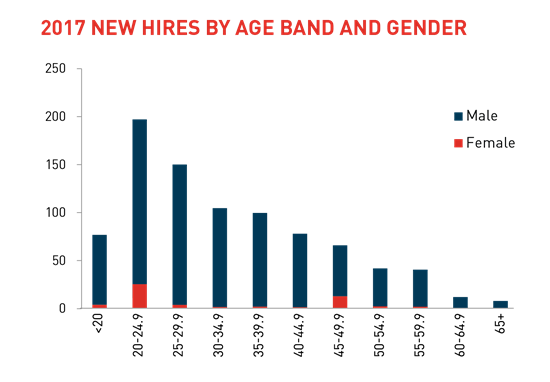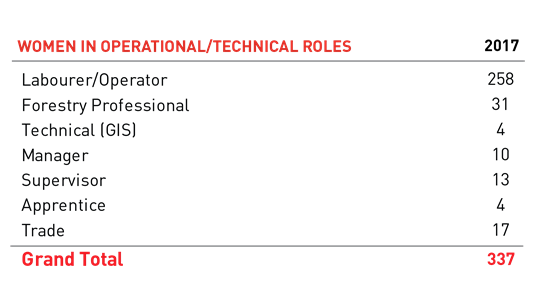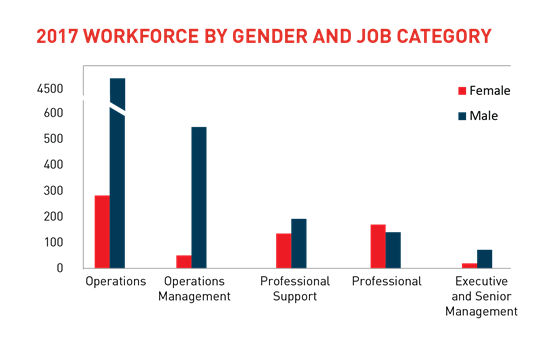Diversity
Canfor recognizes the value to our employees, our customers and our stakeholders that comes with building a diverse and inclusive organization. We aim to promote diversity by valuing and leveraging the unique strengths and experiences in all of our employees and partners. This encourages a wider choice of qualified candidates to explore employment opportunities at Canfor.
Canfor’s current workforce is limited in its diversity and we are committed to taking steps that will lead to increased representation of women, First Nations and other minorities in our workforce. In 2016, our executive signed a diversity leadership commitment to support our efforts. The company also began developing and implementing programs specifically focused on advancing diversity within its workforce.
While we continue to hire candidates with the highest skills and qualifications, we are also developing and implementing programs specifically focused on advancing diversity within our workforce. These include an enhanced recruitment process, investing in talented female employees, and building an inclusive workplace culture. In 2017, 28% of the participants in our accelerated leaders program were women – up from 24% in 2016.
In 2017, we redesigned Canfor’s leadership programs, including our executive development program for senior leaders, our accelerated leaders program for high-potential leaders, our strategic leader program for general managers, and our leader program for managers, superintendents and supervisors. We added new modules focused on diversity so participants can learn the value of a more inclusive culture and diverse workforce; understand how unconscious bias can negatively influence a workplace; and learn the traits of an inclusive leader with practical advice on ways to avoid unconscious bias both personally and with teams.
In April, Barbara Hislop, who served 29 years (1977 to 2004) with Canfor, including as vice president of operations, joined the Canfor Pulp Board of Directors.
We invite candidates to disclose gender or Aboriginal ancestry during the application process. In 2017, about 15% of applicants and 26% of new hires were women, and about 7% of applicants and 5% of new hires self-identified as Aboriginal.
Our Forest Management Group is seeing more women entering the industry and applying for seasonal positions. In 2017, 42 of the 65 candidates interviewed for seasonal field operations and silviculture positions were women – and 14 of the 21 candidates hired were women. This means two-thirds of both short-listed and successful candidates were women.
“It’s really rewarding to see others helping to advance our careers, particularly with those of us who are just beginning our careers.”
- Kimberley Mason, Field Assistant
In November, we participated in the second annual Women in Industry Program in partnership with BC’s Council of Forest Industries and the local Prince George school district. For two days, 20 senior high school students visited our operations in Prince George, met with our staff, and completed mini-projects at welding, fabricating, electrical and millwrighting stations alongside qualified tradespeople.
Our operations in Canada overlap with First Nations’ traditional territories, and we are committed to increasing the participation and advancement of First Nations employees. In 2017, we hired 37 First Nations employees. An optional feature on our application form advises candidates who are of Aboriginal ancestry to email our Aboriginal Relationships Manager if they would prefer to have additional support through the recruitment process. We provided resume and career advice for as many as 200 First Nations candidates.
We encourage First Nations people to pursue career opportunities with Canfor and Canfor Pulp. In 2017 we raised awareness with 12 speaking engagements, six facility tours and an employment forum, as well as meeting one-on-one with Chiefs and Councils and employment/training coordinators and holding interview preparation workshops. Isle Pierre sawmill conducted a tour and talked about career opportunities with Aboriginal youth group BladeRunners from the Prince George Native Friendship Centre.
We are always watching for ways to make our recruitment process more accessible for First Nation candidates. For example, we accept paper-based rather than on-line forms for background information such as reference checks, recognizing that some individuals may not have ready access to computers or reliable internet. We also consider personal references for candidates who may not have worked outside of their Nation.
In 2017, we renewed a collaborative agreement with the Prince George Nechako Aboriginal Employment and Training Association (PGNAETA), which formalized our commitment to Aboriginal job seekers to improve our recruitment and retention process. At the same ceremony, the association once again awarded Canfor its Leadership Excellence Award for incorporating Aboriginal Cultural Competency Training within our organization.
The overall dollar value of the business relationships Canfor has with First Nations is significant. To learn more about Canfor's work with First Nations, visit the Working with First Nations section of this report.
In 2018, we will focus on workplace culture, recruitment and career advancement to benefit existing employees and make Canfor more attractive to a broader range of candidates.
In addition to our commitment to advancing our company with respect to diversity, we are also working to evaluate the impact and effectiveness of our diversity programs, and sharing our diversity metrics in our sustainability reports. Currently, we are limited to age and gender metrics, as well as voluntarily disclosed information regarding Aboriginal ancestry. Included below are the diversity elements that have been tracked to date.
In the future, our new human resources platform will provide more accurate and complete information so we can track and share more elements f our employee demographics. Where possible, all employees will be invited to disclose information about their background through this new corporate human resources system, including Aboriginal ancestry or minority status.

The above chart excludes: WynnWood operation since this was not tracked in 2017; overseas employees since we do not have birth dates for these employees; temporary, seasonal and casual employees as well as involuntary exits and those who retired or are on long-term disability leave.

The above chart excludes: WynnWood operation since this was not tracked in 2017; overseas employees; temporary, seasonal and casual employees as well as involuntary exits and those who retired or are on long-term disability leave.

The above chart excludes temporary, season and casual employees.

The above chart excludes temporary, season and casual employees.

Operations – labourers, operators and trades; Operations Management – supervisors, superintendents and managers; Professional Support – positions within operations business units; Professional – positions within corporate business units; Executive and Senior Management – executives, general managers and directors.